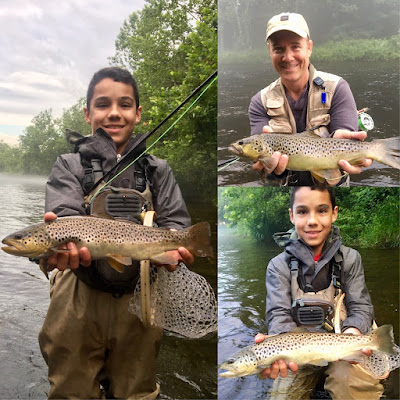Once again the McFarland clan is doing well- dad Mark & son Luke caught some real quality browns on Isonychia ("Iso") dries yesterday, 15+ fish in 2 hours for the father/son duo. Trout LOVE Isos! One of my absolute favorite hatches: it's a big bug, it hatches in daylight, in fast water, and it gets big browns fired up. FYI we got in a bunch of new flies this week, ask and we will point them out.
The FRAA is having a raffle to benefit Veterans (both Rivers of Recovery and Warriors & Quiet Waters). The prize is a premium Douglas Fly Rod Outfit (Sky 9' #5 4pc with Nexus 5/6 reel & Airflo line), they will announce winner on October 18th. Tickets are $20, and only 200 tickets will be sold- tickets are for sale at UpCountry Sportfishing.
Total flow
in the permanent
Catch & Release (C&R)/TMA is currently a medium & beautiful 311cfs (281cfs from dam in
Riverton plus an additional 30cfs from
the Still River) as of 8am this morning (Friday). Water temps of late between the dam (Riverton) and New Hartford are
running from
about upper 50's to mid 60's. Along with the Isos & Cahills, we've been seeing small Olives #22-24 in evenings also.
With great summertime water levels and trout-friendly water temps, the mornings have
been bringing good dry fly action on Needhami Duns #22-26 & Summer/Winter
Caddis #18-24, plus Rusty Spinners and Terrestrials such as ants and beetles.
The best evening fishing is currently after 7:30pm. If
you're out in the evening, stay until dark if you can or you will miss
out on some of the best hatches. Sulfurs #16-18 are only in the upper
river from Riverton upriver to the Goodwin Dam. Isonychia #10-14 and
Light
Cahills #12-14 are found in the evenings throughout the river in light
numbers.
Isonychia #10-14 are hatching from the lower river all the way upstream
to Riverton. Isonychia are a fast water mayfly, so look for them in
riffles, pocket water & pool heads- you WON'T see them popping in
the slow to moderate speed pool water. Hatch time can start as early as
late afternoon and go as late as dark, typically peaking in early/mid
evening. Both the nymph and the dries fish well for this hatch. The
nymph is an unusally good swimmer, so try both dead-drifting &
swinging it, at moments I've even done well making short strips and
retrieving it like a small streamer.
In July/August, many of the hatching insects are smaller, when nymphing
make sure to downsize your flies. #18-20 nymphs are key to success with
fly size more important then the exact pattern (although I love either a little flash or a hot spot in my small nymphs). Some days
small flies are the difference between struggling to hook a trout versus
catching more than you can count! The two main exceptions would be
Isonychia nymphs #10-14, and big Stonefly nymphs #6-12. Iso's are
typically active later in
the day, say late afternoon through dusk. The big Stonefly nymphs
emerge by crawling out onto rocks overnight and in the early mornings.
If you do have a big fly on, make sure you also have another
pattern in your rig no bigger than a #18, it's more in line with what
they are seeing this time of year.
We are closing out our Sage Salt, Sage Accel, Sage Bolt, and Winston Nexus fly rods in
store and online and can be found on our Used / Store Specials
page. Our closeouts are
first come first served and won't last long so don't wait to come in or
place an order.
Cortland's "Top Secret" Ultra Premium
Fluorocarbon Tippet is now in
stock in 3x-8x. This stuff
has been difficult to keep in stock since it arrived recently. Customer & guide feedback on this new product has been
exceptional. No hype or exaggeration, it literally is the world's
best fluorocarbon tippet, hands down. We've found it to
be super strong, unusually flexible, hold & knot like a champ,
very abrasion resistant, have excellent clarity- it just is an
amazingly
durable tippet. The combination of high break strength, stretch, and
perfectly smooth plasma optical quality outer finish make it hard to break off
fish & flies,
and despite the slightly higher price tag, most using it report they go
through it at about half the rate of normal tippet due to it's amazing
durability.
Top Dry Flies: Blue Wing Olives #22-24,
Needhami #22-26 (mornings), Summer/Winter Caddis #18-24 (mornings in
permanent C&R/TMA), Sulfurs #16-18, (Riverton only), Cream Cahills/Light Cahills
#12-14, Isonychia
#10-12, tiny Blue Wing Olives
#18-26, Summer Dark Caddis #16-22, Tan Wing Olive bodied Caddis #16-18.
The best dry fly activity has generally been in the riffles and the upper end of pools including Pipeline,
Roberts, Whittemore, People's Forest, Church Pool,
Greenwoods and the Boneyard. Try also blind-fishing with attractors such
as Mini
Chernobyls #12-16, Stimulators #10-16 & Hippy Stompers #16-18.
Nymphing has been good to excellent for many using things like Caddis
Pupa #14-18 (tan, olive-green, Caddis pupa are especially active in the
mornings), Antoine's Perdigons #16, Frenchies #14-16, Egan's Red
Dart #14, big Stoneflies #8-12 & Pat's Rubber Legs #8-10 (especially in the mornings), Quasimodo Pheasant Tails #14-22, BWO nymphs #16-20,
Isonychia #10-14, Fox
Squirrel Nymphs #12-16, Zebra Midge #16-20.
